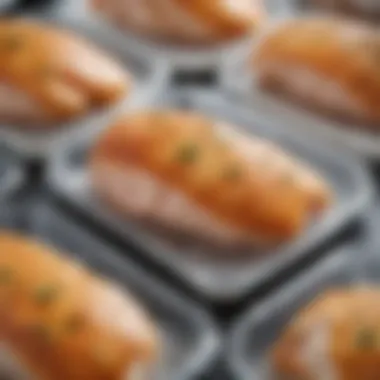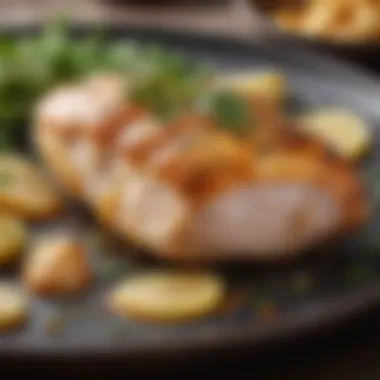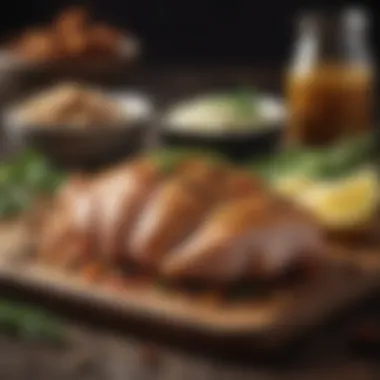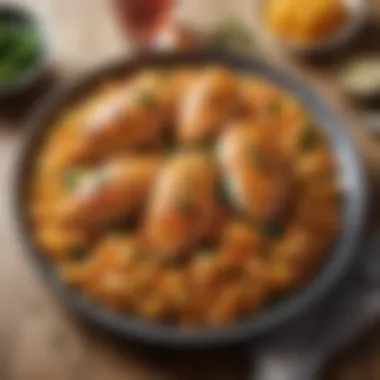Mastering Frozen Chicken Fillets: A Complete Guide


Intro
Cooking with frozen chicken fillets offers an array of benefits that not just save time, but also bring delicious possibilities to your dining table. There is flexibility and convenience in frozen chicken, which becomes vital for those with busy schedules or limited cooking time. This guide underscores how to turn frozen chicken fillets into a superb meal with simple techniques and enticing recipes.
Recipe Highlight
Quick Garlic Lemon Chicken
This recipe proves that simplicity can yield marvelous flavors.
Essential Ingredients:
- 4 frozen chicken fillets
- 4 tablespoons olive oil
- 2 cloves garlic, minced
- Juice and zest of one lemon
- Salt and pepper to taste
- Fresh parsley for garnish
Preparation Time: Approximately 30 minutes.
Servings: 4.
Step-by-Step Instructions
- Prepare Ingredients: Start with laying out your frozen chicken fillets on a cutting board. Defrost them in the microwave briefly if they're stuck together.
- Marinate Chicken: In a bowl, mix olive oil, minced garlic, lemon juice, salt, and pepper. Add the chicken fillets, pressing the marinade into the meat with your hands. Let it rest for 10 minutes.
- Cook Chicken: Heat a skillet on medium-high and add the marinated fillets. Cook for about 7 minutes on each side until fully cooked (165°F internal temperature).
- Serve: Once done, garnish with lemon zest and fresh parsley before serving.
Key Techniques:
- Ensuring the chicken is properly thawed can be crucial for even cooking.
- Proper marination bring forth much richer flavors.
Insider Tips:
- Avoid overcooking the chicken. Use a meat thermometer to check doneness.
- Considering seasoning your chicken hours spear to enhance the taste further.
Variations and Substitutions
- Consider swapping olive oil for coconut oil for a change in flavor.
- You can also use lime juice instead of lemon to achieve a different citrus profile.
- Add some red pepper flakes if you appreciate a bit of heat.
Enjoy your garlic lemon chicken beside a plate of roasted vegetables or a refreshing salad.
Time-Saving Cooking Tips
- Prep Ahead: Chop garlic and zest your lemon in advance.
- Useful Tools: A good meat thermometer for accurate cooking.
- Always cook in batches where possible, making two days worth of meals at once can be effective.
Nutritional Information
- Calories per Serving: Approximately 320 calories.
- Key Nutrients: High in protein, with significant amounts of vitamin C from the lemon.
- Dietary Suitability: This meal is low-carb, making it suitable for keto diets, and can be adjusted for gluten-free needs if ensuring the ingredients are appropriate.
Utilizing frozen chicken fillets can dramatically increase meal prep efficiency and creativity.
Understanding how to elevate basic ingredients into lovely meals makes any kitchen adventure rewarding. With versatile options and handy tips, frozen chicken is a staple worth mastering.
Understanding Frozen Chicken Fillets
Empty nests or busy schedules often demand fast and effective cooking solutions. Frozen chicken fillets serve as an invaluable resource in such scenarios. These convenient products truly emphasize the relationship between saving time and retaining quality in meal preparation.
What Are Frozen Chicken Fillets?
Frozen chicken fillets are precisely what they sound like: chicken fillets that have been frozen to preserve freshness and extend shelf life. They are typically cut from the breast of the chicken and appear as flat pieces of meat. Their uniform shape is ideal for various cooking methods. The freezing process locks in flavor and texture, making them a reliable option for quick meals.
Benefits of Using Frozen Chicken Fillets


Using frozen chicken fillets provides several clear advantages:
- Convenience: They are readily available and allow for immediate meal preparation, minimizing meal choices.
- Shelf Life: Keeping chicken fillets in the freezer prolongs their usability, reducing food waste.
- Cost-Effective: Purchasing chicken in bulk and freezing it can lead to significant savings.
- Nutrition Retention: When frozen quickly after production, chicken retains its nutrients effectively, ensuring a healthy meal choice.
These qualities make frozen chicken fillets an ideal option for diverse culinary needs.
Nutritional Value of Chicken Fillets
Chicken fillets are renowned for their high protein content, making them an essential ingredient in any balanced diet. Approximately 31 grams of protein exist in a 100-gram serving of baked, skinless chicken. The protein plays a significant role in tissue growth and repair. Additionally, chicken offers several vital vitamins and minerals, such as:
- B Vitamins: Chicken contains B3 (niacin) and B6, crucial for energy metabolism.
- Selenium: An important antioxidant that protects cells from damage.
- Phosphorus: Promotes bone health and energy usage.
With proper preparation and cooking methods, the culinary possibilities with frozen chicken fillets are nearly limitless.
Storage and Handling of Frozen Chicken Fillets
Storage and Handling of Frozen Chicken Fillets is crucial to maintain the quality and safety of the meat. Knowing how to handle these fillets properly reflects on the final dish you intend to prepare. To take full advantage of the convenience provided by frozen chicken, focus on techniques of freezing, thawing, and general handling practices. Each aspect ensures that you preserve the meat's flavor and texture while minimizing potential foodborne risks. Proper storage techniques can save time and provide dynamic meal options.
Best Practices for Freezing Chicken
When freezing chicken, maintaining the right temperature is key. Store chicken fillets at or below 0°F, as this effectively halts bacterial growth. Wrapping chicken tightly in freezer-safe packaging helps reduce freezer burn. Labeling your packaging with the freezing date can also enhance organization. Slicing chicken into meal-sized portions makes the thawing process faster, giving you easy access to exactly the amount needed for recipes while preventing the need to refreeze any leftovers.
Thawing Techniques
Proper thawing is essential to avoid uneven cooking and maintain flavor. Here are three popular methods:
Refrigerator Thawing
Refrigerator Thawing involves placing chicken fillets in the refrigerator for an extended period. This method is widely regarded as the safest due to maintaining a consistent temperature below 40°F. It eliminates any risk of the outer part of the chicken entering the danger zone of bacterial growth. The main characteristic of this technique is that, while slow, it ensures the meat remains fully intact without losing moisture. However, it does require foresight, as sometimes it takes an entire night or more. For larger chunks, advanced planning becomes necessary.
Cold Water Thawing
Cold Water Thawing is another viable option when time is pressured. This method requires sealing the chicken in a watertight bag and submerging it in cold water. This approach is much quicker than transferring to the refrigerator, taking about one hour per pound. It is practical for quick meal preparation. A drawback is that you need to ensure the water remains cold, changing it every 30 minutes to avoid any risk of warming. If not, part of the chicken may reach a higher temperature, which can solve badly.
Microwave Thawing
Microwave Thawing utilizes the microwave on its defrost setting, which is the quickest method for thawing chicken. While effective, you must pay attention to the fillet; some areas might start cooking during the thawing phase. Inside steals so much nutrition but timeliness matters a lot here. There's little opportunity to retain the fillet's moisture, sometimes resulting in tough meat. If you choose this method, it is recommended to cook the chicken immediately after thawing to limit any bacteria growth risks.
Safe Handling Practices
Safe handling practices are imperative while dealing with any stored frozen chicken. Always wash hands, utensils, and surfaces before and after handling raw chicken to prevent cross-contamination. When addressing frozen chicken, do not leave fillets at room temperature for extended periods. Such practice invites bacteria.
Putting the chicken back into the freezer after thawing is risky and often leads to unwanted texture and loss of flavor. Plan meals ahead as practicality determines better nutrition and taste.
Unsafe handling of chicken can lead to serious health issues such as salmonella contamination, so follow these practices strictly.
Cooking Techniques for Frozen Chicken Fillets
Cooking techniques play a vital role when using frozen chicken fillets. The choice of a cooking method can determine not just how the meal tastes, but also its texture and overall quality. Proper techniques ensure that the chicken cooks evenly, retains moisture, and meets food safety guidelines. Thorough understanding of these methods can help maximize flavor and convenience in meal preparation.
Direct Cooking from Frozen
Cooking chicken straight from the freezer is a practical option that offers speed without sacrificing taste. This method significantly reduces meal prep time, allowing home cooks to efficiently prepare meals without the need for defrosting. Many culinary experts, however, inform that using a direct cooking method may require slight adjustments in cooking times compared to thawed chicken. Seasoning may also penetrate less effectively, necessitating alternate ways to incorporate flavors.
Recommended Cooking Methods
Baking


Baking is a preferred cooking method for frozen chicken fillets due to its simplicity and effectiveness. By placing the fillets in a gently heated oven, the meat cooks evenly, allowing for a nice browning effect. One key characteristic of baking is its ability to utilize minimal added fat, keeping the dish lighter. This method is not only convenient but also versatile, as it can accommodate various flavors and marinades. Further, baking requires less active time over the stove, free up a cook’s attention for other tasks.
Grilling
Grilling frozen chicken can create a flavorful, charred exterior that is appealing to many. This method allows juices to seal in quickly, reducing the potential for water loss. It’s popular because of distinct grill marks and smoky flavor. However, grilling may require careful temperature control to ensure the inside cooks thoroughly without burning the outside skin. Additionally, excessive sticking can occur without the right preparation, making grilling a task that benefits from pooling good quality oil on grill racks beforehand.
Sautéing
Sautéing chicken fillets is a fast technique that can yield tender and caramelized results. It brings out the vibrant flavors in spices and other ingredients, enhancing the overall dish. One special angle of sautéing involves cooking small portions at high heat, yielding a quick type of dish or stir-fry. On the downside, sautéing may not be ideal for larger frozen fillets, as thicker parts may remain undercooked. Thus, succcesful sautéing often requires cutting fillets into smaller yet more manageable pieces.
Slow Cooking
For those seeking a hands-off approach, slow cooking frozen chicken can produce truly flavorful meals. Notable for developing rich nuances in taste, this method is especially happy with stews or casseroles. After several hours, the meat becomes tender, easily pulling apart. However, slow cooking does consume a longer time before meals are ready; as a result, planning ahead is often necessary. Additionally, oversight of added liquids is crucial to ensure the dish doesn’t dry out, as frozen fillets lose juices as they thaw.
Cooking Times and Temperatures
Understanding cooking times and temperatures is critical for ensuring that chicken fillets are fully cooked yet remain tender. Generally, a meat thermometer reading 165°F is necessary for poultry. When using various cooking techniques, it is recommended to monitor the chicken during cooking closely. Regardless of the method, following reliable guidelines will lead not only to delicious outcomes but also to safe dining experiences.
Quick and Easy Recipes Featuring Frozen Chicken Fillets
Quick and easy recipes are essential in today's fast-paced life. We all seek meals that require minimal preparation, especially when using frozen chicken fillets. These recipes not only save time but also bring convenience without compromising flavor. With frozen chicken fillets, cooks can create meals that appeal to flexibility and speed, ideal for busy weekdays or last-minute gatherings.
One-Pan Dinners
One-pan dinners are a great option when using frozen chicken fillets. Simplicity in cooking can be a significant advantage. A single pan means less cleanup and quicker cooking times. By roasting vegetables alongside your chicken, you combine all ingredients in one cooking phase.
For example, consider a recipe like a frozen chicken and vegetable skillet. With frozen fillets, diffent types of veggies such as broccoli and carrots can be quickly tossed in the pan, seasoned with garlic and herbs. All this brings together in a harmonious blend, saving both effort and dishes. Ensure that the chicken is thoroughly cooked to an internal temperature of 165 degrees Fahrenheit for safe consumption.
Stir-Fry Recipes
Stir-fry is another perfect takeaway when considering recipes using frozen chicken fillets. The speed of cooking comes into play here. Using a hot skillet or wok cooks the chicken equally with fresh vegetables within minutes. Ingredients can vary following dietary preferences, making stir-fries very adaptable.
A recommendation could be a chicken stir-fry with bell peppers, snow peas, and soy sauce. Begin by sautéing fillets with oil over high heat. Add prepared veggies last, tossing briefly till tender. This approach is not just easy but also creates a meal that looks vibrant and colorful on the plate, enriching dining experience.
Casserole Ideas
Casseroles can optimistic solutions when time is limited. Using frozen chicken fillets allows flexibility and variation in ingredients and flavors. With a few pantry staples, such as pasta and cream, a casserole can be made without hassle.
A simple chicken and rice casserole can be prepared quickly. Combine thawed, cooked, and chopped frozen fillets with rice, broth, and vegetables in an oven-safe dish. Adding cheese elevates the flavors while everything bakes uniformly in one pot.
Cooking with frozen chicken can somtimes lead to innovative meal solutions. From quick skillet dishes to effortless casseroles, the options are plentiful. Whether you seek some low-preparation weeknight meal or structure for entertaining, these quick and easy recipes keep frozen chicken fillets relevant in any kitchen.
Adapting Frozen Chicken Fillets for Various Diets
Adapting frozen chicken fillets for various diets is necessary in contemporary cooking. As more people prioritize their dietary preferences and restrictions, knowing how to incorporate chicken into different meal plans can simplify cooking. Chicken fillets are versatile, making them a suitable option for various arrangements, be it low-carb, gluten-free, or with vegetarian ingredients. Understanding how to adapt these fillets means expanding culinary options while maintaining taste and convenience.
Low-Carb Options
Low-carb diets are popular for weight management and health reasons. Frozen chicken fillets fit well here, as they provide essential protein without significant carbohydrates. Options include grilled chicken salad and stir-fried chicken with low-carb vegetables like zucchini or bell pepper. Seasoning is key; herbs such as oregano and basil can enhance flavor without adding carbs.
Pro tips for low-carb meals:
- Focus on adding more leafy greens.
- Utilize oils like olive or avocado for healthy fat.
- Experiment with spices that boost the taste without adding calories.
One straightforward recipe to try is Chicken and Spinach Bake. You need thawed fillets, spinach, cream cheese, and herbs. Layer the fillets in a baking dish, mix spinach with cream cheese, spread over chicken, and bake. This meal is delicious and quick, keeping carbs at bay.
Gluten-Free Recipes


Food intolerances can complicate meal planning, but frozen chicken can easily fit into gluten-free diets. Many common flour substitutes work well for coating, such as almond flour or cornmeal. For example, coating chicken strips in almond flour creates tasty gluten-free chicken tenders.
When seeking recipes, consider:
- Chicken stir-fry with gluten-free soy sauce.
- Baked chicken with crushed gluten-free crackers as a topping.
- Chicken lettuce wraps, using leaves instead of tortillas.
Here is a simple recipe for Gluten-Free Chicken Fajitas:
- Sauté sliced chicken fillets with bell peppers and onions.
- Season with lime juice, cumin, and coriander.
- Serve wrapped in lettuce leaves.
These options punctuate the versatility of chicken fillets while catering to gluten sensitivities without sacrificing taste.
Vegetarian Pairings
Not solely for meat-eaters, chicken can enhance vegetarian dishes too. When cooking for a mixed audience, frozen chicken fillets can be adjacent to a vegetarian platter. Offering diverse combinations can create harmony on a dinner table. Consider meals combining grilled chicken fillets with vegetables or incorporating chicken stock in vegetable-based soups.
A meal idea is chicken and vegetable stir-fry, featuring seasonal vegetables like broccoli and carrots, tossed in a savory sauce made with coconut aminos. The rich umami flavor of chicken complements the veggies efficiently. It provides necessary protein while highlighting plant-based nutrition.
When engaging in vegetarian pairings, think about these tips:
- Balance flavor with texture by combining fillets with crunchy vegetables.
- Explore sauces and dressings that enhance both components.
- Create a shared plate that highlights both chicken and vegetarian options.
Overall, adapting frozen chicken fillets for various diets elevates meal versatility and offers diverse options that meet dietary needs while keeping convenience at the forefront.
Addressing Common Concerns Regarding Frozen Chicken
When it comes to using frozen chicken fillets, several concerns naturally arise. Addressing these common worries is vital for any cook looking to deepen their understanding of this ingredient. Questions about food safety, quality, and cost-effectiveness lead to significant considerations that may impact a person's cooking choices.
By clarifying these concerns, the goal is to empower readers. An informed approach helps in making cotidiana responsible and nutritious culinarydecisions. As we go through these subsections, you’ll discover key insights that can aid anyone in mastering the use of frozen chicken fillets.
Food Safety Considerations
Food safety is at the forefront of using frozen chicken fillets. Knowing how to store and defrost safely is crucial.
Frozen items can have beneficial impacts. For instance, rapid freezing helps to preserve flavor and texture. However, mishandling during storage can introduce risks of bacteria like Salmonella.
Best Practices for Food Safety:
- Always freeze chicken fillets within 1 to 2 hours after cooking or before the
End: Maximizing the Use of Frozen Chicken Fillets
Using frozen chicken fillets provides various benefits for busy individuals and families alike. With plenty of advantages like extended shelf life, ease of cooking, and versatility in recipes, properly integrating frozen chicken into meal preparation can greatly simplify life in the kitchen. This conclusion serves not only to recap vital aspects but also to emphasize how frozen chicken can fit seamlessly into a diverse culinary landscape.
Final Thoughts on Meal Preparation
Frozen chicken fillets are undoubtedly a practical choice for meal prep. Their availability in various recipes makes them adaptable to many cuisines, allowing creativity in the kitchen. Working with frozen chicken can encourage faster meal solutions without sacrificing nutritional quality or taste.
Organizing your cooking schedule around frozen chicken can help ease weekday dinner strains. Preparing sauces or marinades in advance can also enhance the flavour, ensuring quick assembly starts even on the busiest nights.
People should also note to consider daily dietary goals. Frozen chicken fillets not only fit into healthy, balanced meals but also adapt to various preferences and needs. By maximizing the use of frozen chicken, the diversity and accessibility of dinner pleasure can be greatly expanded.
Encouraging Culinary Exploration
Using frozen chicken fillets is a gateway to culinary exploration at home. Through trying new methods or recipes that incorporate these fillets, individuals can broaden their cooking skills. Think of exploring international cuisines, such as creating Indian butter chicken or Italian chicken parmesan. These diverse dishes draw from versatile ingredients and can be easily modified based on what's in your pantry.
Highlights of Frozen Chicken Fillets:
- Quick thawing methods allow for spur-of-the-moment meals.
- The ability to grill, bake, or stir-fry enhances adaptable cuisine formats.
- Benefit from various flavor profiles through marinades or spices when cooking.
Frozen chicken fillets also encourage adopting healthier eating habits by offering lean protein at hand. More importantly, investing time in learning how to use frozen chicken fully can unleash personal creativity and satisfaction.
Ultimately, making frozen chicken fillets a staple in meal preparation serves not just for convenience but also for the benefits it brings in terms of flavor, health, and overall kitchen effeciency. This culinary resource has the power to change the way home cooks treasure mealtime configurations.







